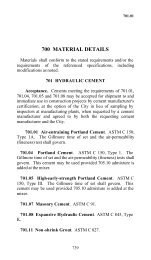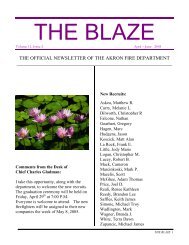Akron Water Pollution Control Station No Feasible Alternative
Akron Water Pollution Control Station No Feasible Alternative
Akron Water Pollution Control Station No Feasible Alternative
You also want an ePaper? Increase the reach of your titles
YUMPU automatically turns print PDFs into web optimized ePapers that Google loves.
4.3.3. Summary<br />
A brief summary statement follows for the feasibility of sewer separation and express sewers.<br />
4.3.3.1. Sewer Separation<br />
From the original and updated costs presented it is not financially feasible to implement a<br />
system-wide sewer separation CSO control approach. However, it is considered feasible to<br />
implement sewer separation in areas designated as Racks 8, 9, 13, 21, 25, 30 and 39 as<br />
proposed in Integrated <strong>Alternative</strong> #2.<br />
4.3.3.2. Express Sewers<br />
From the analysis and evaluation in the Facilities Plan 98 6 and the Long-Term <strong>Control</strong> Plan<br />
Additional <strong>Alternative</strong>s, 2002 Report 10 implementation of express sewers is not a feasible CSO<br />
control alternative.<br />
4.4. Satellite Storage/Treatment <strong>Alternative</strong>s<br />
4.4.1. <strong>Alternative</strong>s<br />
One of the fundamental alternatives for the collection system evaluated in Facilities Plan 98 6<br />
was for storage and treatment. Within storage and treatment approaches there are three<br />
primary alternatives as follows:<br />
• Deep tunnels.<br />
• Storage basins.<br />
• Treatment basins.<br />
Each of these alternatives was evaluated in detail as described in Section 13.2.1 in Facilities<br />
Plan 98 6 . Excerpts from Sections 13.2.1.2 and 13.2.1.3 follow which describe the type of facility<br />
evaluated.<br />
Storage Basins<br />
Storage basins proposed would provide storage, screening, and settling for<br />
overflow volume from the racks, up to the capacity of a selected design storm.<br />
The most cost effective design storm to be used in sizing each basin was<br />
determined through procedures described later. During a storm event, CSO<br />
currently directed to a receiving stream from a rack, would flow to a basin. CSO<br />
volumes greater than the basin’s volume would flow through a shunt channel and<br />
overflow into the receiving stream.<br />
Screening and odor control would be included with each facility. Course bar<br />
screens positioned in the basin influent channel would remove floatables. The<br />
bar screens would have 0.5-inch clear spacing and would provide floatables<br />
removal and protect downstream equipment from large objects in the CSO. The<br />
bar screens would be cleaned by an electrically driven (~5 hp) rake mechanism.<br />
The odor control system would consist of an activated adsorber unit (carbon<br />
Page 4-18







